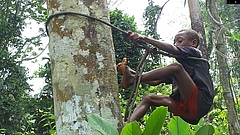How could we evolve such a huge brain?
Specialised foraging skills could have made the essential difference
Based on a media release by the University of Amsterdam
Amsterdam/Leipzig/Jena. A new study, published in the journal Frontiers in Ecology and Evolution, investigated the foraging behaviour of children in a present-day forager society. Already from an early age, there was a gender-specific development of foraging skills. These new findings, combined with the high level of food sharing in forager societies, support the embodied capital theory, offering an explanation for the substantially larger brains in humans. Foraging skills could have provided humans with a more stable energy and nutrient supply, which may ultimately have enabled large resource investments into the brain. The research was led by the University of Amsterdam (UvA), the German Centre for Integrative Biodiversity Research (iDiv), the Max Planck Institute for Evolutionary Anthropology, the Helmholtz Centre for Environmental Research (UFZ), and the Friedrich Schiller University Jena.
Humans have brains three times the size of other primate species. A diverse, high-quality diet and a prolonged childhood with sufficient time to learn complex food acquisition skills are thought to be important evolutionary drivers of our large brains. In contrast to the diet of other primates, the human diet is characterised by a diverse variety of high-quality and difficult-to-acquire foods, such as meat and fish, as well as tubers or many species of nuts and caterpillars. To collect these, complex foraging skills are needed that are thought to be developed from an early age.
To better understand how humans learn these foraging skills, the international research team accompanied 27 children of a modern forager society, the BaYaka, in the Republic of the Congo for one year. The children start foraging independently in peer groups from as young as five years old. The researchers investigated the children’s foraging methods, dietary composition, and botanical knowledge on their daily food-finding trips. Besides observing the behaviour, they also conducted nutritional analyses of the collected food. To achieve this, the researchers set up an interdisciplinary collaboration between a botanist and cognitive behavioural ecologists from the University of Leiden and Amsterdam, chemical ecologists from iDiv, the University of Jena, and UFZ, anthropologists from the Max Planck Institute for Evolutionary Anthropology in Leipzig and nutritional ecologist from the Charles Perkins Centre from the University of Sydney. The fieldwork resulted in a unique dataset containing 798 hours of observational data.
The BaYaka children spent one-third of their time searching and acquiring food. Half of that time, they searched independently from adults and showed a high level of autonomy. “I was impressed to see how skilled the children were already at a very young age”, says Jorin Veen, first author of the paper, who performed this study for his Master thesis at the UvA. “The largest share of the food were fallen fruits, seeds, and tubers, but the children also climbed 40 meters high trees to collect honey or fruits, which can be a risky endeavour.”
Differences between boys and girls
The results revealed an early onset in the specialisation in foraging skills. Foraging groups with more boys were more likely to eat fruits and seeds, which often requires risky climbing skills. Girls were more likely to collect tubers than boys. “Collecting tubers requires exceptional digging skills, as the lianas that lead to tubers are not easy to recognize and keep track off”, explains Prof Karline Janmaat, supervisor of the lead author and researcher at the Institute for Biodiversity and Ecosystem Dynamics at the UvA. “This early onset of a gendered-based specialisation of foraging skills, combined with the high level of food sharing in forager societies, likely enabled the human species to have a more stable energy and nutrient supply – a supply that could have ultimately enabled us to afford a substantially larger brain than our closest living relatives.”
“Our analyses revealed that especially the fruits, which made up 40 per cent of the children’s diet, contained more sugars, especially glucose and fructose, compared to other plant items”, says co-author Prof Nicole van Dam. “No wonder that they put so much effort into obtaining them.” Van Dam, who led the molecular analyses, headed the Molecular Interaction Ecology group at iDiv and the University of Jena until 2022, when she became the director of the Leibniz Institute of Vegetable and Ornamental Crops (IGZ) in Grossbeeren.
This research was financed inter alia by the Deutsche Forschungsgemeinschaft (DFG; FZT-118).
Original publication:
(Researchers with iDiv affiliation and alumni in bold)
Jorin Veen, Haneul Jang, David Raubenheimer, Bryndan O.C.M. van Pinxteren, Vidrige Kandza, Patrick G. Meirmans, Nicole M. van Dam, Susanne Dunker, Petra Hoffmann, Anja Worrich, Karline R.L. Janmaat (2023) Development of embodied capital: diet composition, foraging skills, and botanical knowledge of forager children in the Congo Basin”, Frontiers in Ecology and Evolution. DOI: 10.3389/fevo.2023.935987
Contact:
Jorin Veen
Department of Theoretical and Computational Ecology
Institute for Biodiversity and Ecosystem Dynamics (IBED)
University of Amsterdam
Email: jorinveen@outlook.com
Prof Dr Nicole van Dam
Leibniz Institute for Vegetable and Ornamental Crops (IGZ)
German Centre for Integrative Biodiversity Research (iDiv) Halle-Jena-Leipzig
Friedrich Schiller-University Jena
Email: nicole.vandam@idiv.de
Web: www.idiv.de/en/groups_and_people/employees/details/eshow/van_dam_nicole.html
Dr Volker Hahn
Head of Media and Communications
German Centre for Integrative Biodiversity Research (iDiv) Halle-Jena-Leipzig
Phone: +49 341 97 33154
Email: volker.hahn@idiv.de
Web: www.idiv.de/media

